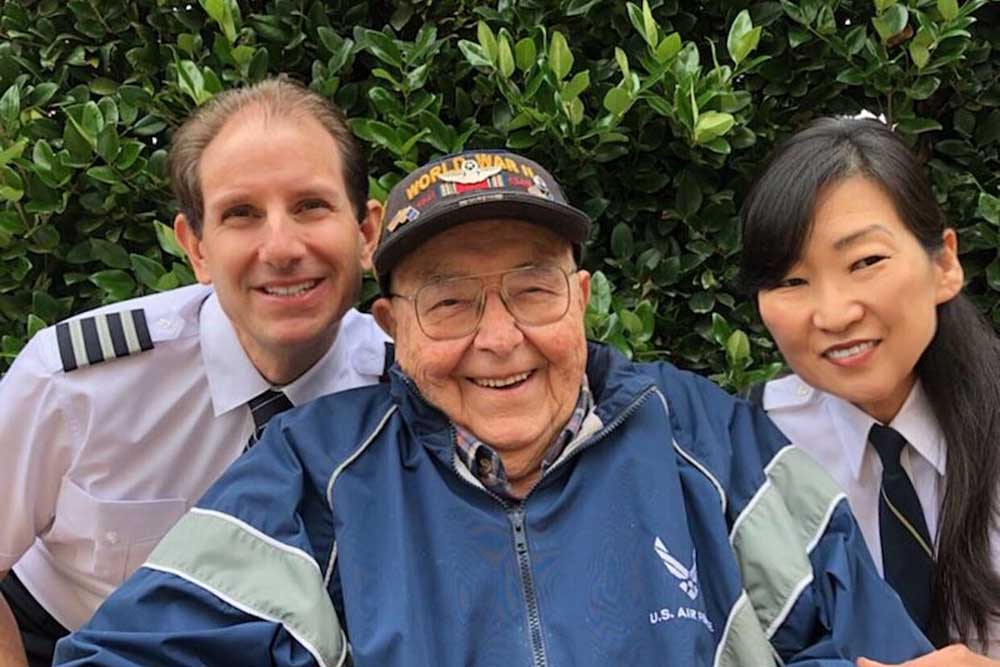World War II Veteran, Test Pilot, Airline Pilot, and Mentor
By F/O Robert Knebel (FedEx Express)

F/O Robert Knebel (FedEx Express), left, with his wife, F/O Kelly Knebel (Alaska), and Uncle John.
My interest in flying isn’t hard to trace. I grew up listening to my Uncle John’s stories about a career that spanned aviation’s golden years and many of its greatest characters and aircraft. John is now 97 years old and is still going strong! He started flying in World War II as an Army Air Corps Air Transport Command ferry pilot flying everything from fighters like the P-51 to bombers like the B-24. At one time, he was checked out in 17 different aircraft. He was one of the first pilots to fly the Lockheed P-80—America’s first jet fighter. After the war, he flew dignitaries including Charles De Gaulle, a man he was not fond of, and Jimmy Doolittle, a friend and man he greatly respected.
After retiring from the Air Force as a lieutenant colonel, he was hired by Convair as a test pilot. He flight-tested the infamous XFY-1 Pogo, an experience he felt lucky to survive! He was also a test pilot on the F-102, B-36, and B-58. He set the transcontinental speed record for seaplanes in 1955 in a CV-R3Y Tradewind, an eight-engine flying boat. Later in his career at Convair, he switched to the airliner division. He was a test pilot on the CV-240, -340, -440, -880, and -990.
One day he was called into the office on short notice. Howard Hughes was there and wanted to take the -880 on a flight. After departing San Diego, Calif., and flying eastbound for a bit, Hughes asked to take the controls. He surprised John and the flight engineer by chopping the throttles and winging the aircraft over, almost into a split S. He told them he was landing in Palm Springs, Calif. After touching down, a car met the aircraft. Hughes thanked them for the flight, leaving them behind.
John left Convair in 1965 as a chief engineering test pilot to fly for the airlines. He worked for several small carriers before starting in 1966 at Trans International Airlines, whose pilots joined ALPA in 1977.Stories of his time there were a major inspiration for my decision to become an airline pilot. He recounted flying to far-flung places all over the world, often on short notice, for the charter airline. He flew cargo to Japan for the U.S. military and a few days later tourists to Paris, France. He told me about the infamous approach into Hong Kong’s Kai Tak Airport with the sharp turn at the checkerboard on the mountain.
Although being color-blind didn’t stop John from flying, my nearsightedness ruled out military flying for me. I started flying at age 16 and worked my way up in civilian aviation. I met my wife, Kelly, now a pilot for Alaska Airlines, when I was a flight instructor.
I got my big break in 2005 when I was hired by World Airways. World, a competitor of Trans International Airlines in John’s time, allowed me to do the same type of flying John finished his storied career doing. I, too, flew both passengers and cargo, and I felt honored to bring our brave men and women home from combat. Trans International Airlines went out of business in the 1980s, and World ceased operations in 2014. I was very fortunate to be hired by FedEx Express and am now flying the MD-11 worldwide again.
John was disappointed when he had to retire at age 60. I can’t imagine a time when I’ll no longer be able to sit behind the controls of an airliner.

